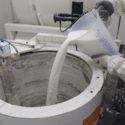Using fine fused silica flours in primary slurries
Prompted by material shortages and unmanageable price increases a few years ago, there has been a move away from fully Zircon slurries to Fused Silica flour. This has been particularly noticeable in the non-ferrous industries where the less demanding nature of aluminium and magnesium alloys has led to an easier conversion from Zircon to REMET Fused Silica.
We have found that particularly the finer particle sized material such as the REMET RP-1 grade or finer that is used in relatively high concentrations in the primary slurry, is difficult to properly wet out in colloidal silica slurry in a timescale that is appropriate to the manufacturing campaign’s demand.
A part of the reason for this is that frequently best practice is ignored in favour of expediency, though in this case it may be a case of more haste less speed. This article describes what we at REMET UK consider to be best practice.
The following procedure should be used to properly wet out the Fused Silica flour in a primary slurry. (Backup slurries have a lower flour to liquids ratio and do not normally present a problem. However, care should still be taken to assure that the Fused Silica flour is properly wet out.)
- Add all the binder and water (if used) to tank and start mixing.
- Add a good wetting agent, such as REMET V12+ to the binder. The wetting agent should be used at a 0.25-0.40 w/w based on the total mass of liquid used. Add the wetting agent slowly. Allow to mix for five to ten minutes to insure it is in solution, and that no separation has occurred. Sometimes a visible separation is obvious, this will disperse over a small amount of time, and if there is any doubt, a propeller mixer can be used.
- Add the antifoam and whatever other liquid adds are to be made. Allow to mix for a minimum of five minutes.
- Add the REMET Fused Silica -325 / -270/ RP-1 / RP2 /RG / EZ flour in slowly, ideally griddling the flour into the tank. Do not allow large quantities to drop in and coagulate if you can help it. If you’re using a propeller mixer, ensure that the material is being added where the mixer will break up the lumps quickly.
- If you’re using a blend, always add the finest flour first.
- Do not pour powder onto un-wetted powder on surface. Sprinkling of powder works best. If another refractory flour such as zircon or REMASIL is to be blended in with the Fused Silica, then, after all the Fused Silica has been added, allow the slurry to mix for one to two hours to allow an initial good wet-in of the Fused Silica add to allow dissipation of en- trapped air before adding these other refractory flours.
- The slurry should be allowed to mix until a constant viscosity measurement is obtained. This could take from 12 hours, but more usually 24 – 36 hours depending upon the type of mixing equipment used.
- The above technique can be tried a few times and then modified, if necessary. If problems still persist, the slurry formula should be looked at to determine if flour loading (total per cent solids) is too high.
SAFETY PRECAUTIONS: Read SDS before using this product.
For further information please visit www.remet.com
Unless specifically identified as a specification value, the above chemical, physical and particle size distribution values are typical properties. They are not specification values.
< Back to insights



